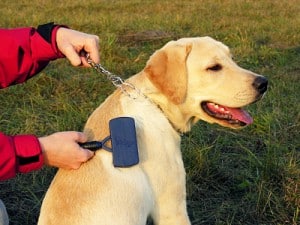The Labrador Retriever sheds slightly differently, depending on the type of Lab that it is.
Yellow labs tend to be more constant shedders, but they still have the same seasonal heavy shed that the black Labs have.
The very heavy shed of the black labs is typically in the spring and fall, and this heavy shed is known as “blowing” the coat.
The heavy shed is due to the loss of the soft and dense inner coat, as opposed to the coarse outer coat that is shed year round by both black and yellow Labs.
All colours of Labrador Retrievers have a double coat. This means that the coat consists of a soft, dense and short inner coat under a coarser, water resistant outer coat.
The outer coat is of a darker colour than the inner coat, and typically only the outer coat is visible when the hair is in its normal position.
To groom the Labrador Retriever, it is important to have the right tools. Regular grooming year round will prevent much hair loss in the house, but there will still be some of the thicker outer hairs shed whenever the dog moves, shakes or scratches. Typically, the basic grooming tools that are required to keep your Labrador looking in top condition include:
- Short hair rake
- Bristle brush
- Slicker brush
The short hair grooming rake is almost a comb like apparatus, that is used to get all the way through both the rough outer coat as well as the thick and dense inner coat. This is very important, to remove all the dead hairs from the coat and prevent any possible irritation of the skin.
Start using the rake from the top of the neck around to the shoulders, and across through to the chest. Never use the short hair grooming rake or any type of comb or brush against the direction of hair growth, as this can cause damage to the hair, leading to skin sensitivity.
Use the grooming rake gently around elbows and hips, and around the stomach area. Never use the rake around the sensitive areas of the dog such as the head, ears or around the reproductive organs.
After brushing completely over the body with the grooming rake, it is time to brush the legs, tail and belly area. The slicker brush is the best tool for this, always grooming in the direction of hair growth. The slicker brush can also be used to groom the tail, moving from the thickest part of the tail at the base to the thinner tip.
A rubber grooming tool can also be used, it is often much easier on the dog’s skin than the grooming rake. The rubber will catch and hold the dead hair and the wide rubber teeth will provide stimulation to the dog’s skin that is pleasant for the animal as well as helping to improve the oil distribution through the coat.
The head and ears of the Lab can be gently wiped with a damp cloth to remove any debris or dirt. The eyes are not prone to gathering debris or tearing, but it is always important to check for any sign of irritation or redness and tearing of the eye.
To finalize the grooming, it is important to use a fine toothed comb to brush out the furnishings on the hind legs as well as the longer hair on the chest. A bristle brush will remove any remaining loose or dead hair, and help keep the coat shiny and health looking.
Labradors are never shaped or clipped. Owners sometimes believe that shaving or short clipping a Labrador will help in keeping the dog cool in the summer, but the reality is that the undercoat will help insulate the dog and keep him or her both warm in the winter and cool in the summer.
BATHING
Labradors, as with all dogs that have been bred for use in the water, have an oily component to their coat that provides water resistance. Bathing a Lab will strip the hair of this natural oil and will result in dry, brittle and somewhat lifeless looking coats.
A Lab should only be bathed when necessary and ideally not more than two to three times per year. If you do have to bathe the dog be sure to use only special shampoo and conditioners for dogs, never use human hair products as they can severely damage the coat and lead to skin irritations.
Teeth
Keeping your Lab’s teeth clean will decrease your need for costly de-scaling and dental cleanings at the vets. It is easy to train your Lab in the tooth brushing process by gradually getting them use to having your finger touching their teeth and gums.
After they are comfortable with your finger along their gums, try using a finger sleeve or a special dog toothbrush. These items are available from your pet store. Use only dog toothpaste, never human toothpaste, as it is likely to be very distasteful for your dog.
Nails
Labs have black nails that make them hard to trim. If you are not sure exactly where the quick is in the nail it is possible to nick a blood vessel causing your dog lots of pain and also resulting in profuse bleeding.
A groomer or vet can show you how to carefully clip the nails using a guillotine style nail clipper to prevent any injury to the dog. Throughout the year most Labs will need only twice a week grooming but during the shed it is important to groom every day.

